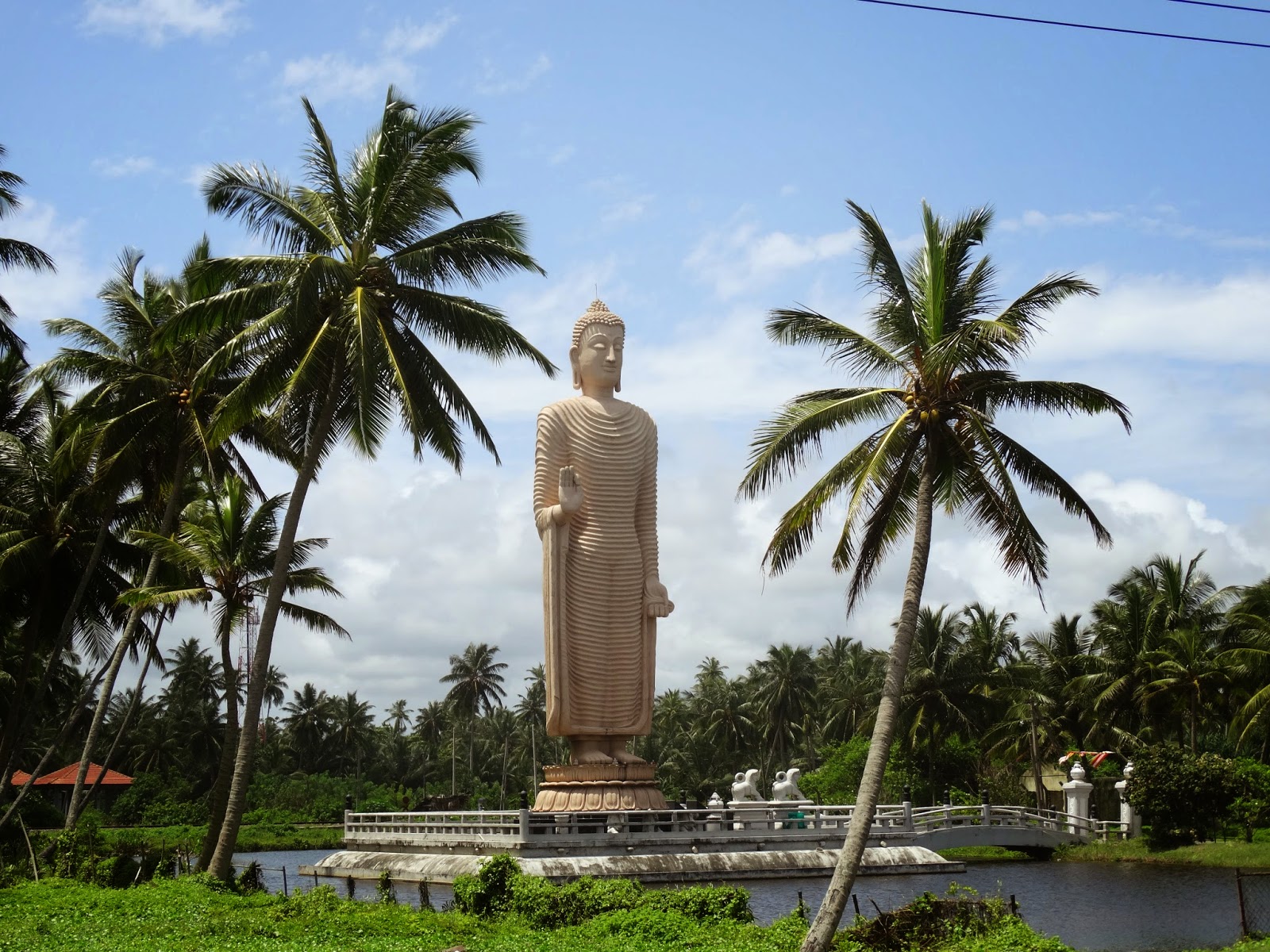Near to the Turtle Sanctuary and Hikkadua lies a tsunami museum. Its comprised of two small huts filled with photos and newpaper articles and facts about the effect of the 2004 tsunami in Sri Lanka. There were some very graphic photographs and a lot of it was quite hard to look at. In particular I was shocked by a photo of Galle Bus Station almost completely flooded up to its roof, since we had just been at that bus station the previous week. I also found drawings by children to be distressing. Drawings of people being washed away, drowning, hanging dead in trees or crying looking for lost family depicted in pictures drawn by children present during the tsunami, completely heartbreaking.
Further along the road from the museum stands the statue that can be seen in my photograph. It was built in remembrance of victims of the Tsunami. The statue stands at 10 metres tall, which is as high as the wave was. I found its pose striking as it appears to be holding out its hand as if to stop another wave.
One story was of a train very near to Ambalangoda, which was travelling on the line from Galle to the capitol Colombo. After the first wave the train came to a stop about 200metres inland. The first wave had caused many people to panic and, not fully realising what was going on, boarded the train as they believed it would be safely secure on the train lines. Many other people stood behind the train in the belief that it would shelter them from any more waves. The train track runs along the coast and so when the second wave came the train was hit, killing the majority of passengers on board. That was around 1700 people on just one train. The numbers from this disaster are very hard to comprehend! This is the highest death toll in a train disaster in history.
''The wave caused flooding in the carriages and began to cause panic amongst the passengers. The next, much larger, wave picked the train up and smashed it against the trees and houses which lined the track, crushing those seeking shelter behind it. The eight carriages were so packed with people that the doors could not be opened, and they filled with water, drowning almost everyone inside, as the water washed over the wreckage several more times. The passengers on top of the train also fell off when the carriages were uprooted, and many of them drowned or were crushed by debris. Estimations based on the state of the shoreline and a high-water mark on a nearby building place the tsunami 7.5 to 9 meters above sea level and 2 to 3 meters higher than the top of the train.'' From Here
Sri Lanka had the second-hgihest death toll from the tsunami with a confirmed death toll of 35,322.
An injury toll of 21,411
and 516,150 displaced persons.
Agriculturally 259 square kilometres of paddy land was destroyed
Countless fisherman had their boats entirely destroyed.
Over 1000 orphaned children
Nearly 4000 children lost one parents.
The effect of the tsunami is an ever-present part of this area of Sri Lanka. On the coastal road driving from here in Ambalangoda through Hikkadua, a road which we regularly drive along, the roadsides are full of ruined houses that were never reclaimed or repaired, and also numerous graves and memorials.
The museum talked about how, as Buddhists, many Sri Lankans believed that the Tsunami was deserved and brought upon them by karma. It left many people confused as to what they had done to deserve it.
Many families never found out what happened to their loved ones and still consider their lost family members to be just that: lost. It also discussed how so many parents, mainly mothers, are to this day in denial that their children were killed, and still believe that they were simply separated and unable to find their way home. That they were taken in elsewhere on the island and are still alive and well and that they could still be re-united. Heartbreaking.
Some quotes from the museum:
''I felt like killing myself after this experience. It was a kind of violence within myself that I can not describe. Why? Is this our karma?''
''It was the sea that gave us everything to live our lives. It was the sea that took all that away and ultimately it is to the sea that we have to return to take up our lives again.''
''A dead child can never laugh again''
''We heard this strange thunderous sound. We thought it was the sound of bombs but it felt like doomsday.''
Being here has brought a sense of realism to the effect the tsnami had on people, I have had conversations with co-ordinator Nalaka, Kanti who cooks for our house and some of our tuktuk drivers about their experiences. One of the afternoon projects is to teach and play at a Tsnami school, which is basically a youth centre built near the 'tsunami village' houses.



No comments:
Post a Comment